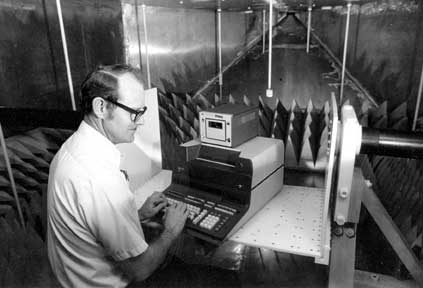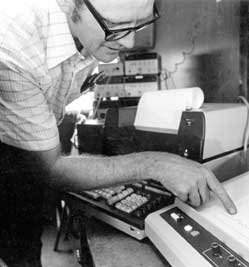The news that Myron (Mike) Crawford had lost
his battle with cancer was received with sadness by all of us
at NIST. Many of us at the Boulder laboratories regarded Mike
not only as a colleague but also as a friend. And for a few of
us fortunate enough to have worked with Mike early in our careers,
he was a mentor and an inspiration. Bill Riddle expresses that
sentiment with this observation, “As I think back on the
years that I worked with Mike here at NIST, I am reminded most
of his infectious enthusiasm and unfailing honesty that he brought
to our work. As an engineer, Mike had an uncanny knack for seeing
the solution to problems based on his intuition alone, and I learned
from him the valuable lesson that it often takes a combination
of instinct and technical know-how to get the job done. He was
a good friend, a great engineer, and above all, a wonderful human
being.”
 |
| Mike Crawford was well known and
respected for his work with the TEM cell, so much so in fact
that it was often referred to as the “Crawford Cell”. |
Mike’s career at NIST (NBS for the old-timers) spanned more
than three decades beginning in 1960. After a few years working
with early near-field-antenna metrology, Mike turned his talents
to the challenging world of electromagnetic compatibility (EMC).
During those years he made many significant contributions to the
science and the art of EMC. Mike is well known as the person responsible
for developing the TEM cell as a useful device for EMC measurements.
You may have heard the TEM cell referred to as a “Crawford
Cell”, a label that seemed to make Mike a bit uncomfortable,
but was well deserved. Mike contributed to measurements of cable
and material shielding properties, radiated immunity and emissions;
in other words, to just about every EMC measurement problem. His
work with coupling into large cavities (i.e. aircraft) set the
foundation for a successful program of aircraft measurement research
currently under way in our group.
 |
| Mike Crawford is shown in the lab
at NIST circa 1978. Galen Koepke recalls, “This is the
view most of us who worked with him in the lab saw day after
day.” |
A new idea for EMC measurements entered the scene around 1980.
Mike put his whole-hearted enthusiasm and experimental prowess
to work to become a leader in developing the reverberation chamber
as one of the most useful EMC tools (well, at least the most complex!).
Mike was a consummate experimentalist; he adhered to a philosophy
that theory was only good if it agreed with measurement data.
Dave Hill recalls his work with Mike at a time when reverberation
chamber theory was just beginning to explain measurement results,
“I had many discussions (and some disagreements) with Mike
in the 1990s regarding measurement techniques and the theory of
reverberation chambers. Mike was definitely an experimentalist
and preferred to answer questions with measurements in the lab,
but he was at least willing to listen to my theoretical opinions.
In the early 1990s, one of the difficult issues was how to measure,
to define, and to calculate the quality factor (Q) of reverberation
chambers. This issue was particularly important because it determined
the field strength that could be generated in reverberation chambers
for immunity testing. Mike was convinced that the Q value obtained
by averaging over stirrer position gave an underestimate of the
Q, so he preferred to use either an adjusted value (his infamous
k factor) or a peak value. The theory predicted that the average
value should give the best agreement with theory if we could take
proper account of all the losses. So even though Mike was skeptical,
he worked very hard on making lots of careful single-frequency
measurements and time-constant measurements based on averaging
over stirrer position (Mike was always great at generating huge
amounts of data). When all was done, Mike achieved the best agreement
between theoretical Q and measured Q (using averaging of both
single-frequency and time-constant data) that had ever been achieved
to that time. Both measurement methods are still used to this
day.”
Mike was the driving force behind the reverberation chamber program
here at NIST. His leadership in this research set a strong foundation
for all the work that followed and continues today. Along the
way, he developed a reputation as the master of filling one graph
with huge amounts of data and reducing it to a simple answer.
John Ladbury, who worked with Mike when he was fresh out of college
in 1987, recalls how this reputation came about, “Mike had
great insight into reverberation chambers. Anyone with much experience
with these beasts knows that the results are always VERY noisy.
We would generate lots of noisy measurements. Mike would take
the data and the plots back to his office and a few hours later
would return with simple clean curves. He would take a French
curve and eyeball some fit to the data. I always figured he was
just guessing or oversimplifying the problem, but the more I have
learned about reverb chambers, the more I have learned that they
do have some very nice and simple characteristics. Mike was right-on
in many of his predictions.”
Mike certainly loved to be in the laboratory working on another
angle to an experiment (or perhaps trying to prove the theoreticians
wrong!). John recalls those times in the reverb lab, “Mike
had a boyish enthusiasm about most of the tasks he faced (except
for paperwork…I really think he hated to spend time in his
office). Whenever we started a new set of measurements or learned
something new, his smile would just glow, and we couldn’t
keep his hands off of the instruments (no matter how hard we tried!).
You could read in his personality that he would drag himself back
to his office to finish the things he needed to, but the lab kept
sucking him back.” We could always tell when Mike had a hand
in setting up an experiment. John remembers the most obvious indicator,
“Although Mike was not one of those big strong linebacker
types, any time he hooked up a cable or pad, I would need a wrench
to remove it. He could tighten a cable tighter than anyone else
I have ever known.”
Mike always worked hard but he was not a workaholic and he knew
how to have some fun. John was fortunate to witness that side
of Mike, “I don’t know if I should relate this, but
Mike gave me my first experience with gambling. One night on a
trip (I think out to Rome, New York) he took me to the bridle
races. These are races in which the horse pulls a cart chariot-style
around a racetrack. I had never done anything like this before,
and Mike taught me how to place bets and how to read the odds.
I don’t think I won a single race (which is probably best
for any first gambling experience), and I think Mike broke even.”
Mike retired from government service in 1994. His attitude toward
retirement is clear in these comments by John, “When Mike
was coming close to retirement age, I remember him saying that
there would be skid marks from his office door to the exit. Some
might think that this means he hated his job, but nothing could
be farther from the truth…he loved his work (at least in
the lab). It just happens that he loved his time with his family
and friends even more. He wanted to take whatever time the Good
Lord decided he had left, and spend it with the people that meant
the most to him. I am glad that he had a good 10 years after he
retired to do just that.”
We have lost a colleague and a friend, an outstanding engineer
and researcher, and a respected member of the EMC community. We
take comfort in the memories and the legacy of Mike’s time
with us.
The RF Fields Group, Electromagnetics Division, NIST, in Boulder,
Colorado, wishes to offer its sincere condolences to Mike’s
family. EMC
In Memoriam
Myron Lloyd Crawford
October 29, 1938 – March 9, 2004
Myron (Mike) Lloyd Crawford passed away on March 9, 2004 ending
a battle with leukemia and finishing a valiant life of faith
and example for his family and friends.
Mike was born October 29, 1938 in Orem Utah. He was a member
of the Church of Jesus Christ of Latter-day Saints. He married
his high school sweetheart Marilyn in the Manti Temple on
March 18, 1958. Upon graduating from Brigham Young University,
they moved to Boulder, Colorado where he lived for 34 years
and worked for the National Bureau of Standards (now known
as NIST).
Although always humble, Mike earned a Master’s degree
from the University of Colorado. He was an IEEE Fellow and
a recognized expert in the field of Electromagnetic Compatibility.
During his remarkable career, he published over 60 technical
papers and received the distinguished Bronze Medal Award from
the U.S. Department of Commerce.
While in Boulder, he developed many lifelong friendships and
served as Scoutmaster and Bishop of the Boulder Second Ward
of the LDS church. Upon retiring, he moved back to Orem, Utah
and he and Marilyn served LDS Missions to Chicago, Illinois
and at the Senior Missionary Training Center in Provo, Utah.
Mike enjoyed gardening, camping, and traveling. He unselfishly
took his family and friends to enjoy seeing the world with
him. He had a firm faith in God and was an example of obedience
and service to everyone who knew him. His greatest joy in
life was to be with his family and especially his 16 grandchildren.
All will dearly miss his gentle teasing, playful nature and
huge pancake breakfasts.
Excerpted from the obituary originally published in the
Salt Lake Tribune on March 11, 2004. |
|
|
|

